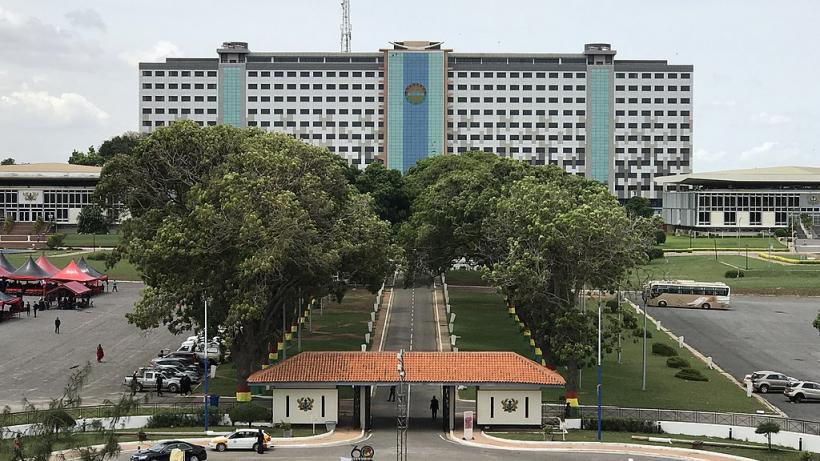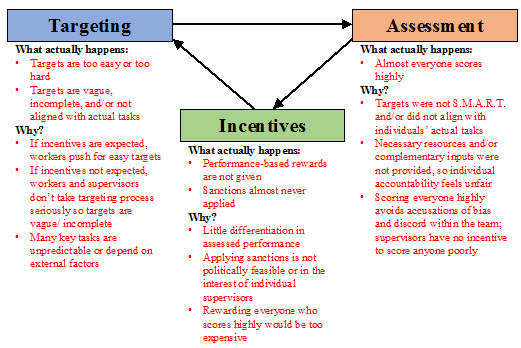
Do civil service performance incentives work: Evidence from Ghana and Zambia
“The problem with government is that bureaucrats don’t have any incentive to perform well.” If you’ve spent much time working in or with governments in low- or middle-income countries, you’ve almost certainly heard this lament many times – and maybe even said it yourself.
The idea is simple, intuitive, and powerful: People aren’t performing well; people respond to incentives; the public sector rarely has strong incentives; therefore, linking peoples’ performance to rewards and sanctions should improve performance. It seems like a common-sense solution to the very real problem of underperforming bureaucracies.
Performance management and incentive pay
This carrot-and-stick approach takes its institutional form in performance management policies that have been implemented, in some form, in many governments worldwide since the 1980s. In African civil services, these have typically taken the form of an annual appraisal process for rank-and-file civil servants and performance contracts for senior management roles.
In economics, performance management systems are often referred to as ‘performance pay’ or ‘pay for performance’ arrangements, and there is a growing body of theoretical and empirical literature on the impact of monitoring, incentives, and performance pay policies in the public sector (c.f. Finan et al., 2015; Khan et al., 2015; Holmstrom, 2017; Rasul et al., 2019). There is a contentious debate about where, when, and what kind of incentive policies are good for performance – which we won’t wade into.
Another emerging theme of these studies is that governments often fail to fully implement incentive pay arrangements for political and administrative reasons (Banerjee et al., 2008; Dhaliwal and Hanna, 2017; Bold et ., 2018). While most of the economics literature focuses on frontline bureaucrats, like teachers and tax collectors, these implementation problems have also bedevilled efforts to implement incentive-linked performance management systems for mid- and senior-level core civil servants who make policy for and oversee the frontline bureaucrats. That’s where our study comes in.
The study: Impacts of incentive-linked performance management reform in Ghana and Zambia
We identified and collected data on two dozen reform episodes in Ghana and Zambia over the last 30 years, interviewing nearly 60 civil servants and reviewing almost 300 project documents and academic studies. Incentive-linked performance management systems were central to almost every major reform implemented during this period, with each country repeatedly trying to implement various types and combinations of individual staff appraisal and leadership performance contracts.
What has happened to all these incentive systems? The results are striking: Over 30 years across both countries, we observed zero successful examples of incentives being systematically and sustainably linked to individual performance. Even when the systems were fully introduced, the promised incentives and punishments never materialised, and the system was viewed largely as a formality disconnected from meaningful consequences.
For example, one civil servant in Zambia remarked that the annual staff appraisal system “was not taken seriously. If you have an appraisal, you need incentives,” (Interview ZAM7, May 2019) while another explained that the system “has mainly been used for administrative convenience… I have never seen someone be demoted due to bad performance.” (Interview ZAM17, May 2019).
An external evaluation remarked, “The result in many instances is a report replete with inconsistencies, contradictions and very little assessment of performance that bears little relation to a real work plan and virtually none to the organisational and strategic plan.” (Universalia, 2008, 27).
Making incentives work: SMART targets
Why is this pattern so strong and consistent? Case studies of each reform identify specific reasons why each one failed in isolation, but the overall pattern suggests that something more fundamental is going on.
We argue that to understand this, one has to think of performance management as a repeated and interdependent cycle of target-setting, assessment, and incentives – as summarised by the diagram below. Every step of this process has to work correctly in order for the system to work as intended. This means that a problem that affects, for example, delivering rewards and sanctions will also undermine the target-setting and assessment stages.
For this cycle to work as it’s supposed to, lots of assumptions about workers, their supervisors, and their organisations have to be true. At the targeting stage, in order for workers to be set SMART (specific, measurable, attainable, relevant, and time-bound) targets aligned with their workplan and tasks:
- workers and supervisors must both invest adequate time in developing meaningful targets;
- the targets from which the individual targets are derived must themselves be SMART;
- organisational or team targets must be divisible into individual tasks so that lines of responsibility can be clearly defined; and
- all or most of the key tasks that individuals will undertake during the year must be able to be foreseen at the start of the year.
However, in reality, most workers ended up with targets that were vague, incomplete, or disconnected from their actual duties. In most cases, this was because the promise of incentives was not credible and so workers and their supervisors did not think it was worth investing time into developing a meaningful set of targets. And since the work of most civil servants is difficult to predict in a comprehensive fashion, workers and supervisors found it necessary to retain some degree of ambiguity in order to accommodate unexpected tasks.
Performance assessment: Unintended outcomes
At the assessment stage, the overwhelming trend in most cases was that almost everyone scored very highly – with the exception of performance contracts for Permanent Secretaries in Zambia, where everyone scored poorly. Both outcomes arguably arise from failures at the target-setting stage.
Since targets were not SMART they could not be objectively evaluated, and the dependence of many civil servants’ tasks on external factors, like budget availability or stakeholder cooperation, made it obviously unfair to penalise civil servants for many of their failures to meet their targets. Supervisors’ path of least resistance was therefore typically to score (nearly) all workers as performing well, to avoid bad feelings, accusations of bias, and discord within their teams.

Figure 1: Intended performance management cycle

Figure 2: Actual performance management cycle
Implications: Credible incentives and meaningful targets
These failures at the targeting and assessment stages had knock-on effects that made it impossible to allocate meaningful incentives. Since everybody scored well and there was little differentiation in performance, rewards would be prohibitively expensive or infeasible and sanctions would be unfair.
Even in the rare cases when there was strong evidence that an individual was performing poorly, both governments found it politically difficult to actually punish people. This was both due to individual managers’ hesitancy to get involved in messy and time-consuming fights, as well as to political interventions and the desire to avoid accusations of bias or politicisation. This absence of incentives then undermined the next year of the cycle, since officers and their supervisors had even less incentive to invest energy into developing meaningful targets – and so on.
This pattern has led to some degree of scepticism around the impact of these reform efforts: “We’ve done performance management reforms, the project came, we’ve trained people on the instruments and so on, but have we got our money’s worth? I’d say not.” (Interview GHA13, December 2018).
Conclusion: Reflecting on performance management is valuable
While this study provides strong evidence that the dominant model of performance management has not been successful in Zambia or Ghana, it also suggests that these reforms have had some positive impacts to the extent that the target-setting and assessment stages have been successful at convening conversations around responsibilities and performance that would not otherwise have happened.
Numerous civil servants at all levels of seniority emphasised during interviews that these conversations were valuable and attributed them to the performance management process. While we lack the large-scale evidence and counterfactual that would be necessary to be certain that the performance management process caused these conversations to happen, this is nonetheless suggestive evidence that the target-setting and assessment stages of performance management can have positive effects on performance even without hard incentives.
Most importantly, this finding poses a question for the designers of future performance management reformers: If linking performance management systems to incentives is unlikely to succeed and risks undermining the parts of the system that do create benefits – at least for middle- and upper-level civil servants – is it still worth building these systems around the assumption that their benefits come from carrot-and-stick incentives?
References
Banerjee, A. V., Duflo, E. and Glennerster, R. (2008). “Putting A Band-Aid On A Corpse: Incentives for Nurses In The Indian Public Health Care System”, Journal of the European Economic Association, 6: 487-500.
Bold, T., Kimenyi, M., Mwabu, G., Ng’ang’a, A. and Sandefur, J. (2018). “Experimental Evidence on Scaling Up Education Reforms in Kenya”, Journal of Public Economics, 168: 1-20.
Dhaliwal, I. and Hanna, R. (2017). “The Devil is in the Details: The Successes and Limitations of Bureaucratic Reform in India”, Journal of Development Economics, 124: 1-21.
Finan, F., Olken, B. A. and Pande, R. (2017). “The Personnel Economics of the State”, in Banerjee, A. V. and Duflo, E. (eds.), Handbook of Field Experiments, Elsevier.
Holmstrom, B. (2017). “Pay for Performance and Beyond”, American Economic Review, 107(7): 1753-1777.
Khan, A. Q., Khwaja, A. I. and Olken, B. (2015). “Tax Farming Redux: Experimental Evidence on Performance Pay for Tax Collectors”, Quarterly Journal of Economics, 131: 219-71
Rasul, I. and Rogger, D. (2018). “Management Of Bureaucrats And Public Service Delivery: Evidence From The Nigerian Civil Service”, The Economic Journal, 128(608): 413-446.
Rasul, I., Rogger, D. and Williams, M. J. (2019). Management and Bureaucratic Effectiveness: Evidence from the Ghanaian Civil Service, mimeo UCL.
Universalia (2008). Assessment of the Current Performance Management System Final Report, Legend Consulting Services Ltd and Universalia.

